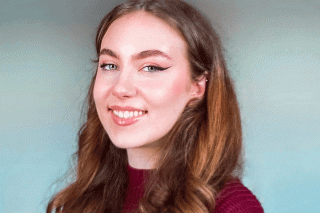Marketing and studio art major Erin Buck ’21 is a recipient of the 3D Award for her project, “Food Justice and Social Impact: A Holistic Exploration of Modern Hunger,” and will speak on this topic at the Undergraduate Symposium. Buck shared with us her approach to creating her 3D program.
Can you tell us about the 3D (Design Across Diverse Disciplines)?
The 3D requires students to construct a “cluster” of three interdisciplinary courses with the goal of developing a more holistic perspective on an issue or topic of interest. Basically, three courses across three majors, one of which can be from your own major(s) and the others stemming from alternate disciplines. While narratives can vary widely depending on students’ individual interests, the goal is the same: to learn how to respond to real-world topics/issues with a more integrative and thoughtful approach. I was excited to design my 3D, as the idea of taking courses outside my fairly rigorous majors felt like a great opportunity. My plan involved a course from my marketing major, an economics course, and a nutrition course.
Tell us about your project, “Food Justice and Social Impact: A Holistic Exploration of Modern Hunger.”
A major challenge when attempting to address global hunger is the scale of the issue — it truly knows no border. In any given period of human history, we can identify populations who grappled with a lack of access to necessary, nutritious foods. While the causes range greatly, we’ve seen the number of individuals and families experiencing hunger and food insecurity increase drastically each year — the UN predicts global hunger will affect about 840 million people by 2030. In light of the effects of the COVID-19 pandemic, access to nutritious food has become even more limited for those already or newly experiencing poverty.
Initiatives to end hunger need to be implemented at different levels to address people’s needs individually and collectively. The structure of my 3D accounts for this as it investigates hunger and food insecurity with local, national, and international perspectives in mind, highlighting the importance of community-centered approaches. My plan involves a three-tiered approach:
- At the local level: My internship at Breaktime, a Boston-based nonprofit, addresses issues of food insecurity and homelessness within the Greater Boston area. (BUS-370: Internship).
- At the national level: I was able to explore supply and demand within a market capitalism context and assess US government policies and activities aimed to improve economic performance and address related social issues like hunger and food insecurity (ECON-100: Principles of Microeconomics).
- At the international level: I hope to build a broader understanding of global hunger, learn more about nutrition policy, and evaluate the effectiveness of large-scale food justice initiatives (NUTR-150: International Nutrition Issues).
I hope that by completing my 3D, I will have strengthened my understanding of how individuals, organizations, and governments can more fully account for different perspectives/needs (concerning hunger or other subjects) and generate positive social impact.
How were you inspired to tackle hunger as the subject of your project?
When considering which topics I would want to explore within my 3D project, I immediately felt drawn to an overarching theme of social impact, questioning how I could most effectively go about creating positive change. In Fall 2020, I served as an intern for Breaktime, a Boston-based nonprofit functioning to end young adult homelessness through transitional employment and financial empowerment. Breaktime's "Double Impact Initiative" provides paid culinary training and employment to young adults experiencing homelessness and helps these associates serve their communities by providing grocery bundles/nutritious meals to food-insecure populations across Greater Boston.
While I was already aware of local food insecurity, this gave me a first-hand perspective of the work being done within the community — by nonprofits, community fridges, and mutual aid organizations — to increase access to nutritious foods. As I had witnessed the value of community-centered interventions, I felt that exploring hunger at the national and international levels would help me develop a clearer understanding of who is affected, why hunger and food insecurity occurs, and what is being done at varying levels in response to such a persistent and complex issue.
Any advice for students looking forward to participating in 3D?
Structuring a 3D course cluster can be challenging, especially as you need to simultaneously identify a compelling subject, schedule accordingly, and meet all design requirements. My own experience required me to scrap my initial 3D plan because of scheduling complications, and that’s okay! What helped me through my uncertainty was my ability to identify a broad, core concept I could hone in on. I would recommend focusing less on the specific courses you’ll be taking, and rather, focus more on the overall theme that will help connect your courses into a compelling narrative. It can also be beneficial to examine the courses you’ve already taken and pull ideas for a 3D design from the classes you felt the most engaged in.
Remember that faculty want to support you in creating a 3D suited for your interests. You can request help from your Simmons Experience or Excel faculty (or other faculty, like your advisor)! Faculty can help you narrow down your selection and ensure that you are meeting all requirements. Successful 3Ds engage and challenge students to develop a broader perspective on their topic of choice — so don’t be afraid to think outside the box!

